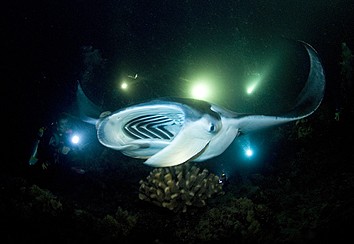

For safety, swimming skills are required for all guests – this is a nighttime open ocean activity.Your helpful Lifeguard Certified guide will provide all the necessary equipment (including Rx masks) and keep you safe and happy on your adventure. Those that are pregnant or have back and neck issues should sit this tour out. Sometimes the ocean is like glass and sometimes has a bit more oomph to it, especially during the winter. This is an exciting, and sometimes bouncy time out on the water depending on ocean conditions. This adventurous retired Navy Seal boat will have you off to see the mantas in no time. (Children (under 18) must be at least five years of age, demonstrate strong swimming ability, and be accompanied by an adult at all times.) Non-swimmers are not permitted on this charter for their safety, our crew’s safety, and courtesy to other guests onboard. A ll guests should be able to swim 50 yards without assistance and consider themselves intermediate to advanced snorkelers. Adults and children (ages 5+) are welcome. The Manta Ray Night Snorkel is open to anyone with a spirit of adventure, who can swim, and is comfortable in the ocean. The manta ray snorkel is one of Kona’s top attractions as there is nothing else quite like it in the world! Float on the surface while these massive rays fly by only inches below! WHO SHOULD GO ON THE MANTA RAY SWIM This tour is suitable for the whole family. Join Kona’s top-rated and most reviewed snorkel company, Kona Snorkel Trips, for the manta ray snorkel experience of a lifetime! They are our sister company and focus on snorkel tours in Kona, Hawaii.


Nevertheless, this trend is also to be considered critically and the attention and development of this kind of trip is to be focused on an educational and sustainable purpose.ONE of THE MOST POPULAR BIG ISLAND SNORKELING TOURS!

With the emerging interest in tourism in the form of manta ray encounters and the possibility to earn money with the animals, they slowly become increasingly valuable alive. Luckily, in March 2013, a regulation of the manta ray trade was approved at the CITES Conference on International Trade in Endangered Species of Wild Fauna and Flora in Bangkok and came into effect on 14 September 2014, which massively reduced the trade and made it illegal. Mantas also often end up as bycatch in the nets and die. The biggest threat is fishing, as humans hunt the species for their gill rakers – especially in the Asian region. But humans pose an even bigger threat to the species. The only natural enemies of the giant manta ray are a few shark species, such as the tiger shark. Entering their habitat and getting too close to them can cause enormous stress, which once again massively reduces the reproduction ability of these endangered animals. Taking this into account, the importance of protecting their natural habitat and ensuring them space seems self-evident. If they experience too much stress, the water is too cold, or they are struggling to find food then they will naturally stop mating for a period of time. Females only mate every second or third year, which makes it hard to increase the population. In general mating can occur any time of the year if they have enough food and the water is a decent temperature for them. The female, 1,9 m wide, died only five days after birth, which shows how sensitive these animals are and that their living conditions were not met. There are only a handful of aquariums worldwide where giant manta rays are being held and in June 2007 the first giant manta ray in captivity was born at the Okinawa Churaumi Aquarium. As they occur in tropical as well as sub-tropical waters and are found along coastal areas all around the world, they are difficult to track. Giant manta rays are an endangered species and little is known about the number of remaining animals and their reproduction. And as is so often the case, we, the humans, are the devils in this relationship. Tourists reach out with their hands, grabbing the manta rays from all sides, screaming with excitement and even kicking the animal with their fins without realizing it. However, observed from a distance, it becomes clear that this ‘close manta ray encounter’, might be a little too close. With this spectacle they are offering tourists a unique close-up experience. Giant mantas continually have to move, which is why they may roll at the bottom of the water to stir up different food sources or they may go in circles around a school of fish to get them to tighten up into a ball, so that they are able to successfully take in a large portion of it at once. Adults can consume up to 66 pounds of food daily which make it clear that they feed whenever there is the chance. They slowly rise to the lights placed on the surface by the tour operators and feed from the attracted plankton.


 0 kommentar(er)
0 kommentar(er)
